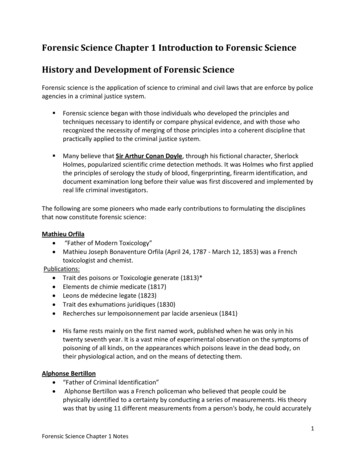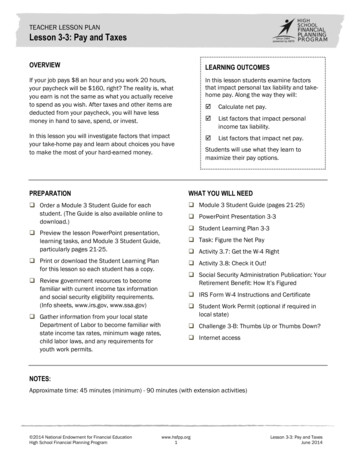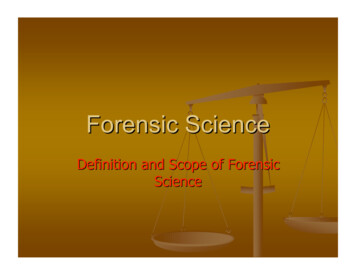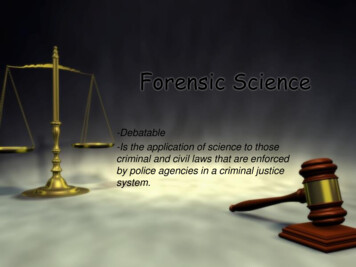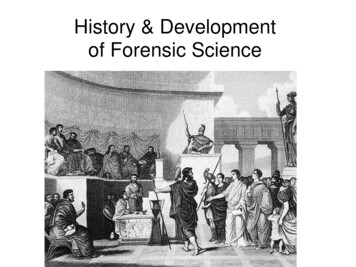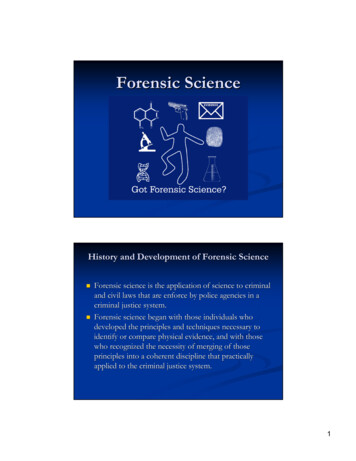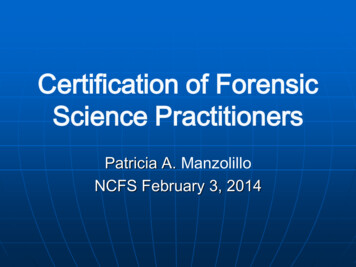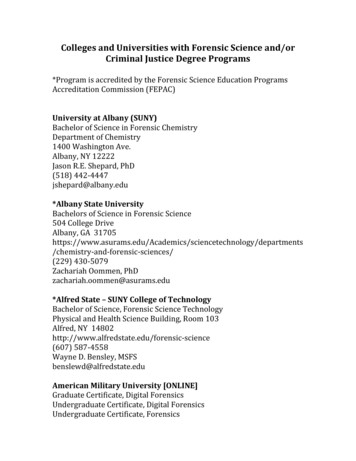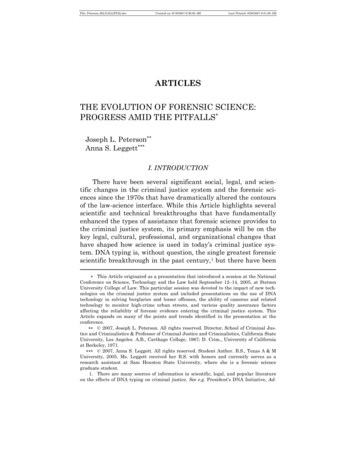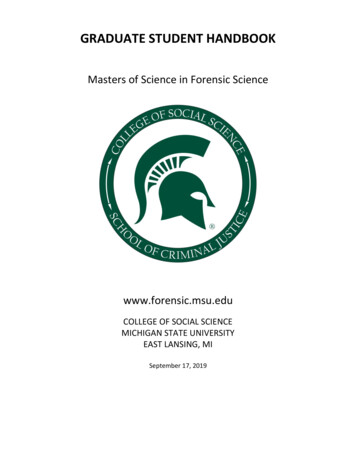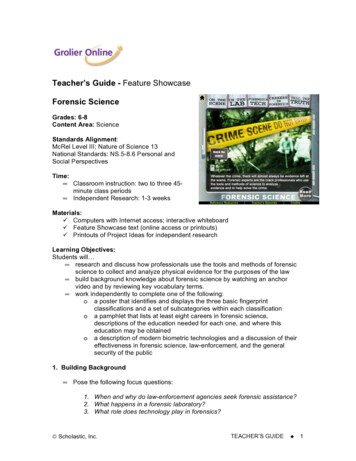
Transcription
Teacher’s Guide - Feature ShowcaseForensic ScienceGrades: 6-8Content Area: ScienceStandards Alignment:McRel Level III; Nature of Science 13National Standards: NS.5-8.6 Personal andSocial PerspectivesTime: Classroom instruction: two to three 45minute class periods Independent Research: 1-3 weeksMaterials: Computers with Internet access; interactive whiteboard Feature Showcase text (online access or printouts) Printouts of Project Ideas for independent researchLearning Objectives:Students will research and discuss how professionals use the tools and methods of forensicscience to collect and analyze physical evidence for the purposes of the law build background knowledge about forensic science by watching an anchorvideo and by reviewing key vocabulary terms. work independently to complete one of the following:o a poster that identifies and displays the three basic fingerprintclassifications and a set of subcategories within each classificationo a pamphlet that lists at least eight careers in forensic science,descriptions of the education needed for each one, and where thiseducation may be obtainedo a description of modern biometric technologies and a discussion of theireffectiveness in forensic science, law-enforcement, and the generalsecurity of the public1. Building Background Pose the following focus questions:1. When and why do law-enforcement agencies seek forensic assistance?2. What happens in a forensic laboratory?3. What role does technology play in forensics? Scholastic, Inc.TEACHER’S GUIDE 1
Preview the key vocabulary words for this topic.ooooooooAutopsy: an examination performed on a dead person to find the cause ofdeathBallistics: the science of forward-moving objects, such as rockets orbulletsDatabase: the information that is organized and stored in a computerDNA: deoxyribonucleic acid, genetic material found in living things. DNAmolecules consist of long chains of four nucleotides: adenine, cytosine,guanine, and thymine. These four “letters”—A, C, G, and T—spell out ourgenes.Forensic: using science to help investigate or solve crimes. A forensicinvestigation uses fingerprints, blood tests, handwriting analysis, andother clues.Gene: one of the parts of the cells of all living things. Genes are passedfrom parents to children and determine how the children look and the waythat they grow.Pathologist: a scientist who conducts autopsies to determine the causeand time of deathPolygraph test: a lie detector test. A polygraph test measuresphysiological responses to questions. The test subject wears electrodeson the skin and scalp, which transmit physiological responses that arerecorded on paper or by a computer. Activate prior knowledge by asking students what they know about forensicscience and where they acquired their information. Then pose the followingquestions and record student responses on the board:oooooWhat is the primary job of all crime-scene investigators?What kinds of clues and evidence can be found at a crime scene?What does a medical examiner (forensic pathologist) do and why?What other types of forensic experts may be called on to identify victimswhen a body is not intact?What kinds of information are obtained from various databases? Show students the home screen of the Forensic Science Feature Showcase.Introduce the topic to the class and explain that you are going to show a short (2minute) video about the topic. Tell students that watching the video first will givethem information and vocabulary that will help them read about and research thetopic later. Write the questions below on the board and ask students to considerthem as they watch the video.ooooWhat do the police do when they first arrive at a crime scene?What three facts about a victim does a pathologist try to determine at anautopsy?What do toxicologists do?What role do forensic scientists play during a criminal trial? Play the anchor video. When it’s over, allow students to volunteer answers to thevarious questions, and write those answers on the board beneath their respective Scholastic, Inc.TEACHER’S GUIDE 2
questions. If you have time, show the video once more and see if the classagrees with the answers. Tell students that they will use the Feature Showcase to begin an in-depth studyof various aspects of Forensic Science. Explain that they can read an article onForensic Science and then explore the following topics in more depth: On theScene, In the Lab, Crime Tech, Forensics Careers, and Tell the Truth. Show thestudents how to view the interactive features, especially the graphical timeline,Forensics Tech.2. Classroom Activity Probably everyone in the class has watched movies or television shows in whichlaw-enforcement agencies and forensic scientists (e.g., CSIs) apply their skillsand knowledge to solve crimes, usually within an hour or two. However, in reallife, the work that these forensic scientists perform does not take place within aset time frame. It involves painstaking efforts, which may or may not besuccessful. Tell students that in this lesson they will learn how real-life lawenforcement professionals and other forensic experts apply different tools andskills to solve crimes and mysteries. Have students work in small groups and use the Internet or other sources toresearch the study of forensic science. Have them begin their research byanswering the question What is forensic science? Give them sufficient time toread the materials and take notes on the various roles and responsibilities offorensic investigators, technicians, and experts, and how they conduct their workat crime scenes, in laboratories, and in courtrooms. After students have completed their research, create a three-column table on theboard with the headings “At the Crime Scene,” “Examining the Victim,” and “Inthe Laboratory.” Then, have each group list the tools and methods within eachcategory that real forensic professionals use to collect and/or analyze evidence.Record their answers in the table. When students have completed reporting on their research, review the entries inthe table and have students describe the importance of each one and theprocedures that must be followed to guarantee that evidence is preserved. Posethe following questions to encourage discussion:oooooWhat do first responders do to secure a crime scene?What are examples of trace, or physical, evidence?What happens during an autopsy?What kinds of instruments or tools do investigators use in the laboratory?How is DNA analysis used in forensic science? Following this discussion, ask students to make a list of the different specialtieswithin the field of forensic science, including those found in law enforcement, thecourt system, and the sciences (such as medicine, chemistry, and computerscience). Have students discuss the many roles that these professionals play,not only at crime scenes and in laboratories, but also in prosecuting or defending Scholastic, Inc.TEACHER’S GUIDE 3
a suspect at trial. Ask students to give examples of actual court cases in whichevidence at trial was used to either convict or exonerate a suspect.3. Independent Research Assign students one of the following Project Ideas. Either read the goals to thestudents or provide them with printouts of the projects. Remind the students howto access the Feature Showcase articles online.Project 1: Poster of Fingerprint Patterns Project Goal: Identify and display examples of the three basic fingerprint patternsand include examples of subcategories within each type if possible. Include ashort paragraph that describes how scientists and law enforcement individualscollect and use fingerprints to make identifications. Get Started: Consider the following questions as you prepare to make yourposter.ooooWhat are the names of the three basic fingerprint patterns?What are the three types of fingerprints that might be found at a crime sceneand how are they different?What is the IAFIS?What is the advantage of computerized fingerprinting used by most lawenforcement agencies today? Resources: From the Feature Showcase, review the articles listed below to findinformation you might want to use in your project.oooOn the Scene (article)In the Lab (article)Forensics Careers (article)Project 2: Pamphlet: So You Want to be a Forensic Scientist? Project Goal: Prepare a pamphlet that describes at least eight different careers inthe field of forensic science. Include a description of the education that isrequired for each career and include the names and locations of organizations,schools, and/or universities that provide the type of education necessary toassume the career roles you have described. Get Started: Use these questions to help you design the information to beincluded in your pamphlet.oooHow is the field of forensics different from the way it is portrayed ontelevision?What is forensic odontology? Forensic anthropology?What roles do forensic engineers play in crime-scene analysis? Scholastic, Inc.TEACHER’S GUIDE 4
Resources: From the Feature Showcase, review the article listed below to findinformation for use in your project.oForensics Careers (article)Project 3: Biometric Technology Project Goal: The use of biological traits to recognize humans is calledbiometrics. Describe at least five current biometric technologies and techniquesin the field of forensic science and discuss how valid and effective thesetechnologies are in identifying individuals. Get Started: The following questions may help you organize your thinking as youprepare your report.oooWhat are “DNA fingerprints” and how effective are they for identificationpurposes?How is photography used today in forensic science?What does a polygraph measure and how reliable is it? Resources: From the Feature Showcase, review the articles and the timelinelisted below to find information for use in your project.oooIn the Lab (article)Tell the Truth (activity)Forensics Tech (timeline) When the assignments are handed in, use the checklists below to assess studentperformance.For Project 1: Poster of Fingerprint Patterns Did students identify the three major classifications of fingerprints (loops, whorls, and arches)? Does the poster include any subcategories within each type of fingerprint? Did students display the information clearly and include labels and captions for their diagrams? Are descriptions about each type of fingerprint coherently and clearly written and free ofspelling errors?For Project 2: Pamphlet: So You Want to Be a Forensic Scientist? Did students select and describe at least eight unique careers in forensic science? Did students explain the education required for each career, and list possible organizations orinstitutions that provide such education? Is the design of the pamphlet useful for someone contemplating a career in law enforcementand forensic science? Is the information legible, well organized, and free of spelling errors?For Project 3: Biometric Technology Does the paper specifically describe recent forensic technologies? Does the paper include examples of a variety of technologies and a discussion of theireffectiveness? Is the paper long enough to address the topic in a comprehensive way? Scholastic, Inc.TEACHER’S GUIDE 5
Does the paper contain a sufficient number of examples and details, including labeleddiagrams as appropriate, to address the topic? Is the writing well organized, grammatically correct, and free of spelling errors?4. Wrap Up Give all students an opportunity to share their research with the whole class.oooFor Project 1, have students display the posters they created while takingturns identifying and describing the classification system used infingerprinting.For Project 2, have students pass their pamphlets around so that everyone inclass can examine them up close. Then ask each student to list thespecialties he or she described on the board and take turns explaining whateach specialist does, the type of education required, and where it can beobtained.For Project 3, ask each student to summarize what he or she learned aboutcurrent biometric technologies and their effectiveness in providingidentification both in forensic science and security. Recap the questions that were posed at the beginning of the lesson:oooWhen and why do law-enforcement agencies seek forensic assistance?What happens in a forensic laboratory?What role does technology play in forensics? Wrap up by asking one or more of these discussion questions:oooDo television shows and movies accurately represent what real-life forensicexperts and investigators do? Explain.Which forensic technique or techniques have had the greatest impact onconvicting or exonerating a suspect in a crime? Why?Should methods of forensic science and technology be extended to includethe examination and surveillance of the general public? Why or why not? Scholastic, Inc.TEACHER’S GUIDE 6
of various aspects of Forensic Science. Explain that they can read an article on Forensic Science and then explore the following topics in more depth: On the Scene, In the Lab, Crime Tech, Forensics Careers, and Tell the Truth. Show the students how to view the interactive features, especially the graphical
